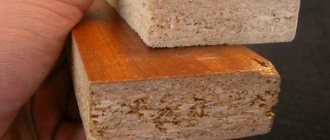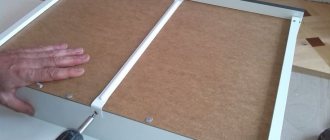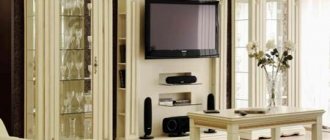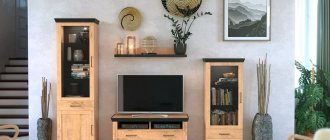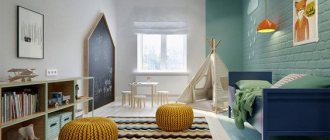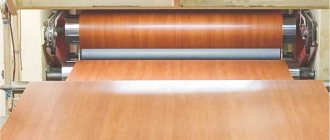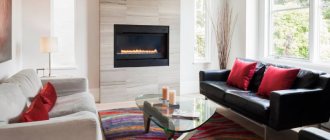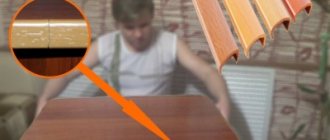30.04.2019
To organize furniture production from scratch, you need to have a clear understanding of furniture manufacturing technology . A properly organized enterprise can generate stable income for its owner for many years. Let's consider the main stages of the manufacturing process of cabinet furniture products.
Tools, equipment
Even a small enterprise that will be engaged in the manufacture of single pieces of furniture will not be able to get by solely with hand tools. Equipment purchases typically account for the bulk of costs. Experienced furniture makers believe that to produce high-quality products in accordance with all the rules of technology and cabinet furniture production, you cannot do without:
- format-cutting machine for cutting elements of hull assembly;
- edge banding installation for edging parts made of wood boards;
- drilling and additive machine for drilling holes for fasteners;
- drying chamber for drying lumber.
In addition, you will need equipment for glass processing: a sandblasting machine, devices for cutting and drilling sheet glass. Don’t forget about hand tools, which include:
- screwdriver;
- Grinder;
- furniture stapler;
- jigsaw;
- shoe knives for cutting thin materials;
- measuring instruments: tape measures from 2 to 5 m, steel rulers and squares;
- thick scribe awl;
- rubber and metal hammers;
- clamps for fixing parts with a grip of at least 100 mm;
- flat and Phillips screwdrivers of different lengths and thicknesses, hex keys for confirmations, pliers, wire cutters;
- cutters, drills of various diameters, including a Forsnel drill, discs for a cutting machine;
- sanding belts of different abrasiveness classes.
In the process of further work, the need to replenish the fleet of equipment and tools corresponding to the complexity and scale of the tasks being solved will certainly become clear.
Equipment for furniture production
One of the main factors in opening a profitable furniture production is the correct selection of machines for furniture production. Purchasing such equipment is not a particular problem if you have the required amount of funds. It is important to choose the right equipment based on the scale of production and type of furniture. It is the question of what machines are needed for furniture production that is the most common among young entrepreneurs in the furniture industry.
The main range of equipment for furniture production consists of the following items:
- Edge banding machine;
- Format-cutting machine;
- Reismus;
- Four-sided machine.
This equipment is a basic set for starting any production from scratch. Of course, in the first stages of launching production, you may not purchase some items from this list. However, all these systems will be essential for the development of efficiency and large-scale production. Almost all machines can be initially replaced with hand tools, but it is worth understanding that such tools will reduce the speed of furniture production, work efficiency and the overall profitability of the business.
If at the beginning of your business there is not enough money to purchase the entire set of machines, you can consider the option of renting such equipment. This step is very common and correct, since it allows you to reach the planned scale of production with minimal start-up investments.
There is also the option of searching for craftsmen who will design and create equipment with their own hands. Such a decision, most often, turns out to be irrational for business. Self-assembly of machines is suitable only for small production volumes. In addition, the cost of building it yourself can reduce profits to zero, given the complexity and low speed of work on homemade equipment.
Design of cabinet furniture and selection of materials
To quickly develop projects for furniture products, special computer programs are used. Today it is not difficult to choose the right software for making furniture, since the market for these software products is extremely large. Many programs are available in a free version, which allows you to save money at least at the initial stage. Some of them allow you not only to develop drawings and visualize them in volumetric form, but also to calculate project estimates for different materials.
At the design stage, the appearance and functional elements of the furniture are determined, the overall dimensions of the product and the materials from which it will be made are selected. Based on the project, fittings and fasteners, decor and inserts, and other details are selected. Drawings of product elements for cutting are made, and an assembly flow chart is drawn up.
Accessories
No furniture can do without high-quality and functional fittings - front and fasteners. The first type includes parts that serve only for decoration. This is an important part of the interior, which is always in sight. Facial accessories include:
- door handles;
- hooks for clothes;
- decorative locks and much more.
It is better to take products from Italian manufacturers - they are famous for their quality.
Depending on the design of the room, you can choose front fittings made of plastic, wood, metal or glass. There must be a special coating that reduces friction and protects against mechanical stress. Fittings of the second type perform the function of fasteners, connecting parts and increasing the reliability of furniture. It should be compact, durable and made of quality materials. This type includes:
- loops;
- shelf holders;
- bolts;
- mechanisms for drawing drawers;
- seals.
Furniture hinges are used to open door leaves, but with their help you can make a mechanism for transforming structures.
Door handles
Coat hooks
Locks
Loops
Shelf holders
Bolts
Drawer pull out mechanisms
Seals
Cutting blanks
Modern furniture, as a rule, is made from wood panels, so an important stage in its production is cutting - the process of cutting out parts from a solid chipboard board. It is best to do this using a cutting machine, since it will cut the slab with maximum accuracy. The cutting is carried out in accordance with the drawing, the chipboard sheet is pre-marked to the dimensions of the parts. Curvilinear sections are cut with a jigsaw.
Registration: management forms, OKVED and documents
For the production of cabinet furniture, you can register an LLC or individual entrepreneur. The form of business management depends on the scale of the enterprise. If mass production is planned, then LLC will be optimal. If the products will be made to order and in small batches, then individual entrepreneur is better.
To register with the Federal Tax Service you will need to provide:
- Charter and constituent documents (for LLC).
- Receipt for payment of state duty: 800 rubles. for individual entrepreneurs, 4000 for LLC.
- Bank details: bank accounts.
- Application form P21001 for opening an individual entrepreneur or P11001 for an LLC.
When registering, you also need to indicate OKVED codes.
For production.
- 36.12 - furniture for offices and retail establishments.
- 36.12 - for the manufacture of kitchen furniture.
- 36.14 - production of other furniture.
For sale.
- 52.44.1 - retail sales.
- 51.47.11 - wholesale sales.
- 52.61.2 - retail sale through teleshopping, radio, online stores or by telephone.
In addition to the Federal Tax Service, you must register with the pension fund. Do not forget about the mandatory authorized capital for an LLC - from 10,000 rubles.
“If registering a business seems like a complicated and time-consuming process, then it can be delegated to a law firm. The lawyers will carry out all the necessary procedures themselves and hand over the completed documents to you.”
Machining the ends of parts
The outer ends of the parts must be covered with a special edge tape, which will cover the unaesthetic cut and serve as an obstacle to moisture getting inside the chipboard. Pasting is carried out on a special edge banding machine, where gluing occurs with heating, which means that the requirements of cabinet furniture manufacturing technology .
In the absence of a machine, the edge is heated with an iron or an industrial hair dryer, but in this case there is no talk of decent quality due to uneven heating. On the machine, simultaneously with gluing, the edge is trimmed if its width is too large. When gluing with an iron, trimming is done manually with a shoe knife, which sometimes leads to the formation of burrs on the edge. Therefore, a mandatory step in gluing the edges is sanding the cuts with fine sandpaper until completely smooth.
Manufacturing
To successfully make cabinet furniture with your own hands, you must carefully follow all the steps:
- preparation of parts;
- processing of sections;
- marking of fittings;
- installation.
Having completed the calculations and begun assembling the product, in no case should you work without a drawing or act at your own discretion. If a new idea arises, you should create another diagram that will take into account all the amendments.
Preparing parts
When working from scratch, you first need to cut out the furniture parts - thick paper or cardboard will do. Next, you will need a high-performance machine with a high cutting frequency. Having placed the workpieces on it, you need to cut the material, saving space if possible. This will help reduce wood costs.
Ready-made options can be found in furniture departments and on the market. In this case, no machines will be required. If the raw materials are not processed, then the parts must first be covered with self-adhesive film or special plastic.
Cut out parts
Cut
Processing slices
Before you start assembling the parts, you need to glue the sections. For this you will need edge tape. Before work, you need to make sure that the humidity in the room is low - it is advisable to dry and warm the workshop well. You will also need equipment; a regular iron and a construction knife will do. Sometimes the edge is initially equipped with a sticky layer, then there is no need to further treat the surface.
Features of the use of furniture polishes, popular brands
During gluing, the iron should be kept at a short distance from the cut to prevent possible displacements and to secure all parts well. If you overexpose it, the edge may overheat and burst. When it is fixed, use a knife to trim the edge and smooth out all the irregularities.
Tape over the sections
Trim edge
Clean up uneven areas
Marking of fittings
Correct technology involves placing the finished parts of future furniture on a flat surface for marking. Following the plan, you need to mark all the places where the fittings will be attached. It is advisable to double-check the dimensions, since an error of 1 cm can distort the entire structure. Next, you need to make holes in the marked places and screw in the fittings.
Mark and drill holes
Screw in the fittings
Installation
In accordance with the plan, the cut parts must be connected. For screeding, it is important to prepare a screwdriver with special attachments. This way the twisting will happen much faster than with a screwdriver. Nails should not be used to strengthen the bottom. The best choice would be self-tapping screws measuring 4 by 16. All edges must be fastened at an angle of 90 degrees using corners. You can nail the back wall to the assembled frame.
In order for the sliding mechanisms to operate smoothly, the guides must be properly fixed. They should be attached parallel to the horizontal edges of the product. Then attach special rollers to the doors, the movement of which checks the operation of the entire mechanism. After installing the sliding system, the furniture begins to shrink, which can cause gaps to appear. This is considered normal and depends on the characteristics of the material.
All that remains is to attach the fittings. All shelves, hooks and drawers must be installed in their places. The product is ready for use. Even an inexperienced person can handle the design of cabinet furniture.
Making cabinet furniture allows you to acquire useful skills that in the future will help you create entire sets for various rooms. All products in the house will have a unique design that will surprise and delight guests. For example, assembling a cabinet takes no more than 3 hours for novice craftsmen.
Selection and installation of accessories
The parts are marked for subsequent drilling of mounting holes, and then the drilling itself is carried out. When measuring distances, high accuracy is necessary so that later, during assembly, there are no distortions. After marking, the holes are drilled on a drilling machine, which does not allow the drill to be deepened beyond the required depth. The holes are thoroughly cleaned of dust and sawdust.
The correct choice of fittings is extremely important when making furniture, because the functionality of the product depends on it. Doors should open easily and close securely, drawers should pull out without distortion or getting stuck. The design of the fittings is chosen in accordance with the overall style of the furniture. The fittings are fastened using a screwdriver.
How to choose quality fittings
There are a great variety of alloys from which furniture fittings are made, so there is no need for a non-specialist to understand all these intricacies. In addition, manufacturing companies are constantly improving the quality of their products and patenting new compositions. The main things you should pay attention to when choosing accessories:
- The manufacturer's logo must be in the most visible place and clearly legible.
- The color of the metal must be uniform, without stains, burrs, roughness, or streaks.
- Open fittings are a thing of the past; it is better to give preference to hidden mechanisms.
- When opening and closing doors, they should not creak, knock, wobble or generally cause any suspicion.
- Drawers should not rattle, jam, or slide to the side.
- The finishing mechanism, if present, must work without any complaints.
By following these recommendations, you can not only choose high-quality furniture that is suitable in price and functionality, but also purchase a product that will last for many years, maintaining its presentation.
Assembly of cabinet furniture
Unlike the technology for manufacturing upholstered furniture , which includes cutting and sewing upholstery, cabinet furniture consists only of solid elements, for assembly of which metal fasteners and wooden dowels are used. It is important that workers follow the established order of connecting parts. First, the frame elements are connected, then the back walls are attached to them, mirrors and glass inserts are installed, and the fittings are checked for correct fastening. Then they install retractable elements - drawers, roll-out shelves, etc.
Compliance with all requirements of cabinet furniture production technology is the key to high-quality assembly. Customers will definitely appreciate the quality and impeccable appearance of the products, which will very soon have a positive impact on the number of applications and the growth of the furniture company’s profits.
Market Review
Where to start furniture production? Before opening a furniture shop, be aware that small and medium-sized businesses in this area typically specialize in something specific. You should not grab hold of producing everything in a row, but you should try to make every effort to gain a foothold in some narrow niche. This is a fundamental rule in the survival strategy in furniture production. You can focus your efforts on your own production of the following furniture:
- hull;
- soft;
- advertising;
- for trade organizations.
Promotional furniture is used to decorate points of sale and attract as many buyers as possible to a product or service. For trade organizations, such as shops, pharmacies, shopping centers, salons, special shelves and display cases are required on which the assortment will be displayed.
Furniture manufacturing involves a large number of specializations. You can focus your efforts on collecting any products with limited functionality, such as, for example, Euro pallets or computer tables, or you can make glass tables and cabinets, or produce furniture from a specific material - plastic, natural wood.
Furniture manufacturing as a business does not only mean creating goods. Services for restoration of cabinet and upholstered furniture are also popular. These services are especially in demand among citizens with low incomes, and there are many of them in the country. The opposite direction is the restoration and restoration of antiques. In this case, services will be in demand in regions that are economically developed.
An unoccupied niche in this market includes the production of wicker furniture. A small enterprise can master it, but wicker chairs, sofas, and cabinets continue to be imported from abroad, leaving them in the high price segment.
An excellent specialization for small and medium-sized businesses is built-in furniture. In this case, an individual approach to each client is required. Large enterprises cannot satisfy individual customer requirements.
To understand whether it makes sense to start a furniture manufacturing business, pay attention to the development trends in related fields. If the real estate market is developing, foreign cars are being purchased, the market for antiques and advertising services is developing, and this dynamics can be observed in the next two to three years, we can start in this direction. On the other hand, there will always be demand for furniture: after its decline, the upward trend returns very quickly.
Organization of production
Where to start making furniture? Once you have decided on your specialization, you need to find a suitable room. The minimum required area that will be required is 200 m2. Its rent will cost 1300-6500 rubles per year per 1 m2. This price range depends on the region.
In Moscow and St. Petersburg, you need to adjust to the cost of 1 m2 at 5-6.5 thousand rubles. per year, and in regions, especially economically undeveloped ones, you can quite count on the lowest prices. The average is 3,300 rubles per year per 1 m2. Total rent will cost 650-660 tr. in year. If you can rent a room for a cheaper long-term, that will be very good.
Depending on the specialization, you need to spend from 350 thousand rubles on equipment. up to 1.5 million rubles. This does not take into account the purchase of office equipment, software, or a truck with which the furniture will be delivered to the consumer or to points of sale. You can purchase both standard machines and entire production lines that are made to order.
Pay attention to purchasing quality components. Please immediately note that it is impossible to produce furniture that will be of high quality and competitive, while relying only on domestically produced parts and fittings. You will have to establish connections with distributors of foreign companies that offer everything you need for furniture production.
Decide in advance and make a list of component suppliers, enter into supply agreements:
- MDF boards;
- laminated boards;
- films on slabs;
- paint and varnish materials;
- accessories;
- aluminum profiles;
- sliding systems.
At the initial stage, it is necessary to duplicate suppliers for each position. Diversify your assortment so that there is more than just the production of chipboard furniture. During the work, some of them will be eliminated, cooperation will continue only with some of them, which turned out to be reliable and favorable in the price range.
Next, it remains to resolve the issue with the staff. The level of training of employees must be high, but they also require high pay. You can organize your training in your specialty if you have the experience and qualified personnel for this.
The staff of a furniture workshop should include:
- master;
- assembly fitter;
- carpenters;
- glazier.
The production workshop can accommodate from 10 to 50 people, depending on the volume of production.
In addition to these, you also need:
- driver;
- Sales Manager;
- courier;
- storekeeper;
- designer.
The general wage fund (payroll), if there are no more than 15 employees, is from 350 thousand rubles.
These calculations are valid for the general case. Depending on the specialization and scale of the region, they can change both downward and upward. For example, for economically underdeveloped regions the wage fund will decrease, but for Moscow and St. Petersburg it will increase several times. Let's look at specific examples in the niches for the production of cabinet and upholstered furniture.
Production of cabinet furniture
The production technology of cabinet furniture includes the following:
- preparation of a project for the intended product in different planes;
- work on cutting materials, forming parts of the future product;
- work on drilling holes and sockets for fasteners;
- work on trimming edges;
- final assembly of finished furniture.
This process depends on how automated it is. It is believed that the use of CNC machines reduces the percentage of manual labor and increases process automation. The operator of such a machine only needs to enter the size data into the program, create the required product, and once the machine is started, it will cut out everything that is needed in a few minutes. This manufacturing method is considered advanced and high-tech.
The disadvantage of such production is that constantly reconfiguring the program for an individual order is considered an unprofitable exercise. Therefore, the use of CNC machines is not suitable for working with individual orders. The best option is to organize furniture production on several machines, which form a semi-automatic line with combined manual labor.
For such a furniture manufacturing workshop you will need to purchase the following equipment and tools:
- format-cutting machine with manual supply of materials;
- edge banding machine, with which straight edges, concave and convex elements are lined;
- drilling and filler machine, which allows you to make holes - both blind and open;
- grinding machine;
- screwdrivers and hammer drill;
- cutters, drills, knives.
With all this, you can count on a simultaneous monthly production of 100 units:
- cabinets;
- tables;
- cabinet;
- shelving.
A total of 400 units of finished products. The expenses must include the following:
- for materials;
- for electricity,
- for advertising;
- for depreciation.
In addition, the cost of furniture production is formed by payroll and rent. The payroll together with wage taxes is about 400 thousand rubles, rent is 50-55 thousand rubles. The cost of 400 of these products will be about 500 thousand rubles.
The cost of a table or cabinet varies from 2.3-3.3 thousand rubles, and the cost of cabinets and racks - 3.5-5 thousand rubles. The approximate income will be 1160-1660 tr. The profit will be 590-1060 tr. per month. This is the perfect calculation. To obtain real numbers, the final values can be divided in half, even if labor efficiency is high.
Production of upholstered furniture
The population's need for upholstered furniture forms a sixth of the entire furniture market, which makes this niche very promising and attractive for both medium and small enterprises.
There is a trend towards the production of sofas and armchairs to order, which makes it possible for small enterprises to successfully compete with large industries that will not pursue individual customers. It is convenient for small and medium-sized businesses to produce small batches of armchairs and sofas.
This niche is also attractive for small and medium-sized businesses because it does not require the purchase of expensive equipment.
Basic operations are performed manually. Finally, such small and medium-sized businesses easily adapt to fashion trends and are ready to quickly fulfill an order, even if a new product has just appeared on the market. For this, the factory needs a quarter to transfer the equipment and technological process to the production of some specific models. A small workshop can only provide the customer with a whole line of models through combinations of upholstery, fittings and materials, thereby benefiting from exclusivity.
Your production of upholstered furniture requires the purchase of the following machines:
- combined - for wood processing;
- multi-saw edger;
- turning;
- milling;
- crosscut;
- grinding.
Their total cost is 150-160 thousand rubles. In addition to machines, you will need drying equipment and pneumatic clamps, as well as hand tools, a sewing machine and cutting tables. This is another 40 tr. In total, the technology for producing upholstered furniture will require about 200 thousand rubles for equipment and tools.
In addition to equipment for the production workshop, you will also need to purchase office equipment - office equipment and furniture with a total cost of 60-90 thousand rubles. This equipment allows us to produce up to 100 sofas monthly, each of which can be offered for sale at a price of 7.5 thousand rubles. The enterprise's income will be from 750 thousand rubles.
The costs of producing upholstered furniture are:
- Payroll - 150-250 rubles;
- rent - 50 thousand rubles;
- materials - 150 tr.;
- electricity, utilities, internet, communications - 20 thousand rubles;
- advertising - 30-50 t.r.;
- unforeseen expenses - 40-60 tr.
In total, the total production costs are 440-580 thousand rubles. The enterprise's profit before taxes is 170-310 thousand rubles, and after - 160-290 thousand rubles. The real profit value will be 1.5-2 times lower. The average payback period for investments in equipment and tools in this type of activity, if efficiency is high, is considered normal from 4 months.
Manufacturing of facades
Take into account the production of facades. The number of enterprises that specialize in this is growing every year, but many manufacturers’ products are not of high quality. Buyers are willing to spend more money on high-quality facades, therefore, if you focus on product quality and do not strive to reduce costs due to it, then the production of facades can turn out to be a very profitable enterprise.
To open your own production, you will need 1.5 million rubles. One equipment, its purchase, delivery and installation will cost 1 million rubles. You also need to provide for the purchase of raw materials for a month of furniture production, which will cost another 250-300 thousand rubles.
One person can operate the equipment, so the payroll will be small. Such a furniture production workshop produces 400-500 m2 of MDF facades per month. The cost of 1 m2 reaches 1 thousand rubles. The income of such an enterprise is 400-500 thousand rubles. Consumables - up to 200 tr. The initial investment will pay off in 8-12 months.
What to focus on?
How to organize your furniture manufacturing business to achieve high labor efficiency? First: it is necessary that safety precautions are observed. Second: the staff must have a personal interest in high-quality production. Therefore, establish that the salary is formed from a fixed rate and a percentage for the work performed, and the marriage is deducted from the salary. This will increase employee engagement and improve labor efficiency.
After the work in the workshop has improved, begin an active search for customers. You can sell products both through retail chains in your city and in other cities.
It is very good if you have your own online store to sell manufactured furniture. If you invest money in its promotion and contextual advertising, it allows you to increase sales several times, while advertising costs will be low.

